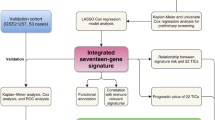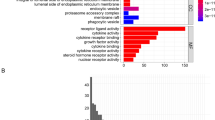Abstract
Ewing's sarcoma (ES) is the second most common primary malignant bone tumor in children and adolescents. Currently accepted clinical prognostic factors fail to classify ES patients' risk to relapse at diagnosis. We aimed to find a new strategy to distinguish between poor and good prognosis ES patients already at diagnosis. We analysed the gene expression profiles of 14 primary tumor specimens and six metastases from ES patients, using oligonucleotide microarray analysis. The over-expression of two genes was validated by quantitative PCR using the LightCycler system. We identified two distinct gene expression signatures distinguishing high-risk ES patients that are likely to progress from low-risk ES patients with a favorable prognosis of long-term progression-free survival. The microarray-based classification was superior to currently used prognostic parameters. Over-expressed genes in the poor prognosis patients included genes regulating the cell cycle and genes associated with invasion and metastasis, while among the downregulated genes were tumor suppressor genes and inducers of apoptosis. Our results indicate the existence of a specific gene expression signature of outcome in ES already at diagnosis, and provide a strategy to select patients who would benefit from risk-adapted improved therapy.
This is a preview of subscription content, access via your institution
Access options
Subscribe to this journal
Receive 50 print issues and online access
$259.00 per year
only $5.18 per issue
Buy this article
- Purchase on Springer Link
- Instant access to full article PDF
Prices may be subject to local taxes which are calculated during checkout





Similar content being viewed by others
References
Alizadeh AA, Eisen MB, Davis RE, Ma C, Lossos IS, Rosenwald A, Boldrick JC, Sabet H, Tran T, Yu X, Powell JI, Yang L, Marti GE, Moore T, Hudson J, Lu L, Lewis DB, Tibshirani R, Sherlock G, Chan WC, Greiner TC, Weisenburger DD, Armitage JO, Warnke R, Levy R, Wilson W, Grever MR, Byrd JC, Botstein D, Brown PO and Staudt LM . (2000). Nature, 403, 503–511.
Benjamini Y and Hochberg Y . (1995). J. Roy. Stat. Soc B., 57, 289–300.
Bernards R and Weinberg RA . (2002). Nature, 418, 823.
Burchill SA . (2003). J. Clin. Pathol., 56, 96–102.
Bussemakers MJ, Van Bokhoven A, Tomita K, Jansen CF and Schalken JA . (2000). Int. J. Cancer, 85, 446–450.
Eisen MB, Spellman PT, Brown PO and Botstein D . (1998). Proc. Natl. Acad. Sci. USA, 95, 14863–14868.
Fouts RL, Sandusky GE, Zhang S, Eckert GJ, Koch MO, Ulbright TM, Eble JN and Cheng L . (2003). Cancer, 97, 1447–1452.
Ginsberg JP, Woo SY, Johnson ME, Hick MJ and Horowitz ME . (2002). Ewing sarcoma family of tumors: Ewing's sarcoma of bone and soft tissue and the peripheral primitive neuroectodermal tumors. Principles and Practice of Pediatric Oncology, 4th ed. Pizzo PA and Poplack DG (eds), Lippincott-Williams and Wilkins publishers: Philadelphia, Pennsylvania, pp 973–1016.
Hajra KM and Fearon ER . (2002). Genes Chromos. Cancer, 34, 255–268.
Iguchi H, Imura G, Toh Y and Ogata Y . (2000). Int. J. Oncol., 16, 1211–1214.
Im Y-H, Kim HT, Lee C, Poulin D, Welford S, Sorensen PHB, Denny CT and Kim S-J . (2000). Cancer Res., 60, 1536–1540.
Khan J, Wei JS, Ringner M, Saal LH, Ladanyi M, Westermann F, Berthold F, Schwab M, Antonescu CR, Peterson C and Meltzer PS . (2001). Nat. Med., 7, 673–679.
Mahoney MG, Simpson A, Jost M, Noé M, Kari C, Pepe D, Choi YW, Uitto J and Rodeck U . (2002). Oncogene, 21, 2161–2170.
Markus MA, Reichmuth C, Atkinson MJ, Reich U, Hoffmann I, Balling R, Anderer U and Höfler H . (1999). J. Pathol., 187, 164–172.
Mishra SK, Mazumdar A, Vadlamudi RK, Li F, Wang RA, Yu W, Jordan VC, Santen RJ and Kumar R . (2003). J. Biol. Chem., 278, 19209–19219.
Nawa A, Nishimori K, Lin P, Maki Y, Moue K, Sawada H, Toh Y, Fumitaka K and Nicolson GL . (2000a). J. Cell. Biochem., 79, 202–212.
Nawa A, Sawada H and Toh Y . (2000b). Int. J. Med. Biol. Environ., 28, 33–39.
Nicolson GL, Nawa A, Toh Y, Taniguchi S, Nishimori K and Moustafa A . (2003). Clin. Exp. Metast., 20, 19–24.
Nielsen TO, West RB, Linn SC, Alter O, Knowling MA, O'Connell JX, Zhu S, Fero M, Sherlock G, Pollack JR, Brown PO, Botstein D and van de Rijn M . (2002). Lancet, 359, 1301–1307.
Oberlender SA and Tuan RS . (1994). Cell. Adhes. Commun., 2, 521–537.
Park BW, Kim KS, Heo MK, Ko SS, Hong SW, Yang WI, Kim JH, Kim GE and Lee KS . (2003). Breast Cancer Res. Treat., 80, 79–85.
Pishvaian MJ, Feltes CM, Thompson P, Bussemakers MJ, Schalken JA and Byers SW . (1999). Cancer Res., 59, 947–952.
Ramaswamy S, Ross KN, Lander ES and Golub TR . (2003). Nat. Genet., 33, 49–54, 2003.
Schulz S, Becker K-F, Braungart E, Reichmuth C, Klamt B, Becker I, Atkinson M, Gessler M and Höfler H . (2000). J. Pathol., 191, 162–169.
Shibata T, Ochiai A, Gotoh M, Machinami R and Hirohashi S . (1996). Cancer Lett., 99, 147–153.
Shin CS, Lecanda F, Sheikh S, Weitzmann L, Cheng S-L and Civitelli R . (2000). J. Cell. Biochem., 78, 566–577.
Shing DC, McMullan DJ, Roberts P, Smith K, Chin S-F, Nicholson J, Tillman RM, Ramani P, Cullinane C and Coleman N . (2003). Cancer Res., 63, 4568–4576.
Shipp MA, Ross KN, Tamayo P, Weng AP, Kutok JL, Aguiar RCT, Gaasenbeek M, Angelo M, Reich M, Pinkus GS, Ray TS, Koval MA, Last KW, Norton A, Lister TA, Mesirov J, Neuberg DS, Lander ES, Aster JC and Golub TR . (2002). Nat. Med., 8, 68–74.
Takeichi M . (1991). Science, 251, 1451–1455.
Terrier P, Llombart-Bosch A and Contesso G . (1996). Semin. Diagn. Pathol., 13, 250–257.
Toh Y, Kuwano M, Mori M, Nicolson GL and Sugimachi K . (1999). Br. J. Cancer, 79, 1723–1726.
Toh Y, Oki E, Oda S, Tokunaga E, Ohno S, Maehara Y, Nicolson GL and Sugimachi K . (1997). Int. J. Cancer, 74, 459–463.
Toh Y, Pencil SD and Nicolson GL . (1994). J. Biol. Chem., 269, 22958–22963.
van de Vijver MJ, He YD, van't Veer LJ, Dai H, Hart AAM, Voskuil DW, Schreiber GJ, Peterse JL, Roberts C, Marton MJ, Parrish M, Atsma D, Witteveen A, Glas A, Delahaye L, van der Velde T, Bartelink H, Rodenhuis S, Rutgers ET, Friend SH and Bernards R . (2002). N. Engl. J. Med., 347, 1999–2009.
vañ't Veer LJ, Dai H, van de Vijver MJ, He YD, Hart AAM, Mao M, Peterse HL, van der Kooy K, Marton MJ, Witteveen AT, Schreiber GJ, Kerkhoven RM, Roberts C, Linsley PS, Bernards R and Friend SH . (2002). Nature, 415, 530–536.
Yeoh E-J, Ross ME, Shurtleff SA, Williams WK, Patel D, Mahfouz R, Behm FG, Raimondi SC, Relling MV, Patel A, Cheng C, Campana D, Wilkins D, Zhou X, Li J, Liu H, Pui C-H, Evans WE, Naeve C, Wong L and Downing JR . (2002). Cancer Cell, 1, 133–143.
Acknowledgements
This work was supported by the Josefina Maus and Gabriela Cesarman Maus Chair for Pediatric Hematology Oncology (RZ). This work was performed in partial fulfillment of the requirements for the PhD degree of Anat Ohali, Sackler School of Medicine, Tel-Aviv University, Israel.
Author information
Authors and Affiliations
Corresponding author
Rights and permissions
About this article
Cite this article
Ohali, A., Avigad, S., Zaizov, R. et al. Prediction of high risk Ewing's sarcoma by gene expression profiling. Oncogene 23, 8997–9006 (2004). https://doi.org/10.1038/sj.onc.1208060
Received:
Revised:
Accepted:
Published:
Issue Date:
DOI: https://doi.org/10.1038/sj.onc.1208060
Keywords
This article is cited by
-
Ubiquitous Neural Cell Adhesion Molecule (NCAM): Potential Mechanism and Valorisation in Cancer Pathophysiology, Drug Targeting and Molecular Transductions
Molecular Neurobiology (2022)
-
Polymerase independent repression of FoxO1 transcription by sequence-specific PARP1 binding to FoxO1 promoter
Cell Death & Disease (2020)
-
Predicting synthetic lethal interactions in human cancers using graph regularized self-representative matrix factorization
BMC Bioinformatics (2019)
-
Protein phosphatase 1 regulatory subunit 1A in ewing sarcoma tumorigenesis and metastasis
Oncogene (2018)
-
Implementation of next generation sequencing into pediatric hematology-oncology practice: moving beyond actionable alterations
Genome Medicine (2016)



